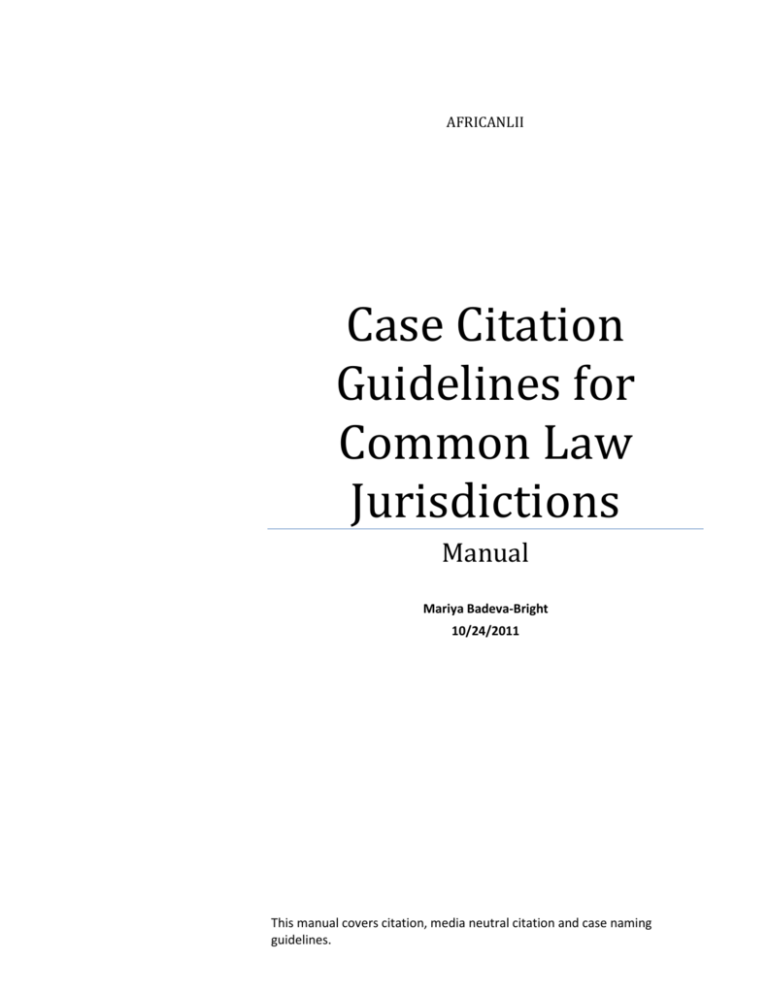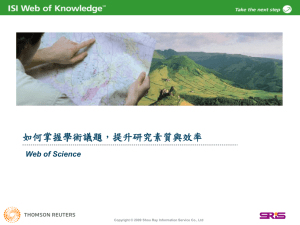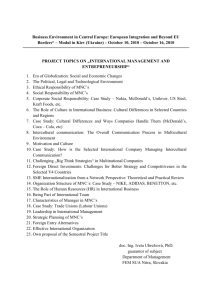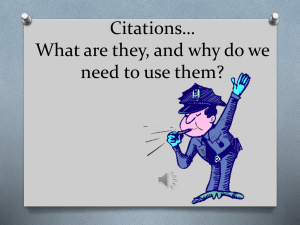Case Citation Guidelines for Common Law Jurisdictions
advertisement

AFRICANLII Case Citation Guidelines for Common Law Jurisdictions Manual Mariya Badeva-Bright 10/24/2011 This manual covers citation, media neutral citation and case naming guidelines. 1.0 Case Naming Guidelines Case Citation Guidelines for Common Law Jurisdictions Case Law Citation In the content collection and management for NATIONALLII you will work with two types of citation: - a print Law Reports citation, e.g. Republic v. Chirwa, 7 MLR 8, which will be referred to as parallel citations from now on; and the - Medium Neutral Citation – a global standard for electronic publication of judgments. The NATIONALLII system will allow you to display both on the website, thus facilitating the researcher in finding information. General remarks on Law Reports and Citation In its content collection, NATIONALLII publishes all judgments without discriminating on the basis of reportability criteria. However, as part of NATIONALLII’s offering of value-adds, we include here the reportability criteria that Law Reports around the world have adopted. This criteria may serve NATIONALLII to highlight significant cases on the front page, thus assisting users with finding information on NATIONALLII. Which decisions are reported? According to an article in t(1985) 59 (10) The Australian Law Journal 616-20 at 618-19, ‘novel law’ may be of a number of kinds, including: (a) a decision of a question on which there is no binding authority or no clear binding authority … (b) a decision the reasons for which clarify the law where previously its expression has been obscure (c) a decision that an authority applies to novel facts, which may be regarded as a special case of (a) (d) a decision that an authority in another jurisdiction may be followed here, so turning probability into certainty 2 1.0 (e) a decision that an old or criticised authority is still good law (f) a decision in an area where the law is changing, either to show a tendency that will lead to overruling earlier authority or to show that the courts are not yet ready to go so far (g) a decision explaining a decision the exact application of which was arguable Square vs. round brackets Round brackets indicate that the volumes of the law report are issued in continuous series, where the numbers of volumes are continuous and consecutive. If the year appears in the citation in round brackets it means it is not essential to locating the correct volume of the report series. Round brackets should indicate the date the decision was handed down rather that the date on which the judgment was published in the report. This may lead to confusion when a decision is handed down and the year of the decision differs from the date the report was published, or where there is more than one year indicated in the report. Square brackets indicate that the year is essential to locating the correct volume. The year is essential when a law report series has no volume numbers, uses more than one volume number within a year, or restarts volume numbering at the beginning of each year. The Medium Neutral Citation Standard The legal profession relies on authority (case-law and legislation) and persuasive secondary legal literature (scholarly works, preparatory works, dictionaries, etc.) to build and present legal arguments. The core purpose of case law citation is to accurately identify a judicial opinion or a part thereof – traditionally, its location in a printed law report series. In traditional law reporting, case citations do not reflect information about the case itself, but rather identify the year, volume and page number of the law report(s) that contains the judicial opinion. Case Naming Guidelines October 2011 • 3 1.0 Case Naming Guidelines References to specific parts of a judicial opinion (pinpoint referencing) are also in general based on the page number and the paragraph letter. The digitization of the judicial opinions allows courts to make judgments available immediately through the Internet or other media, in comparison to commercial publishers who take between a month and sometimes years to publish a judgment in the law reports. While obviously impacting on the greater accessibility of judicial opinions, the legal profession and the media still need a reliable method for referencing such electronic decisions. Substitutes for the commercial publishers assigned citations and for page numbers must accompany such judgments. A survey of international practices in this regard shows that courts have taken steps to address these issues by introducing Medium Neutral Citations and Paragraph Numbering within the final versions of judgments. The Medium Neutral Citation (MNC) allows a resource such as a judgment to be cited irrespective of its publishing medium, namely, in print form or in electronic form, regardless of whether they have been, or will be published in any printed law reports series. The MNC serves as a permanent unique identifier assigned by the author of the judgment and should remain associated with the judgment wherever it is published in various media or publications. The MNC enhances the discoverability of judgments across publications, such as commercial law reports series, NATIONALLII and other websites. The MNC includes a global identifier of the issuing court, made up from the ISO-3166-1 standard two-letter country code and an abbreviation of the tribunal’s name. The MNC should be assigned by the court to the final version (filing and distribution version) of judgments. The MNC includes the case name and the core part of the citation: the year, the court identifier and the sequential number. [<year of publication>] <court identifier> <sequential number> Case name: 4 1.0 The MNC standard does not specify the make-up of the case name. This is dependent on the law reporting practices of the jurisdiction in which the court operates. Additional guidelines will be provided. Core part of the citation: a. The year element represents the year the decision was handed down, enclosed in square brackets (e.g. “[2007]”). b. The court identifier follows the information relating to the year of the decision. Each court has a distinct court identifier. Different seats of the courts (e.g. a high court that has seats in different towns in the country) are not included in the court identifier unless they matters in jurisdictional terms. c. The sequential number represents the consecutive number of the decision in relation to other decisions handed down in a particular year by the particular court. Example: Candlex Ltd v Katsonga is the first judgment handed down by the Malawi High Court in the year 2004, hence the core MNC assigned to the judgment is: [2004] MWHC 1 Instead of paginating judgments, courts now have adopted the practice of assigning paragraph numbers to distinct paragraphs within the text of a judicial opinion. Example from the Supreme Court of Namibia: STRYDOM. A.J.A.: Case Naming Guidelines October 2011 • 5 1.0 Case Naming Guidelines [1] This is an appeal from the Special Tax Court of Appeal. The respondent ( i.e. the appellant in the Court a quo), objected to a tax assessment by the Receiver of Revenue in terms whereof it was assessed at a rate of 55% of the money recouped in respect of the sale of five of its vessels after they had ceased rendering services in connection with the mining for diamonds to Namdeb Diamond Mining Corporation (Pty) Ltd (“Namdeb”). The respondent maintained that the taxable income, derived from the sale of the vessels, was subject to tax at a rate of 35%. [2] The respondent’s objection was disallowed by the Commissioner for Inland Revenue. The respondent then launched an appeal to the Special Tax Court where it was successful and where that Court ordered that the assessment of that income be reduced in accordance with the rate of normal tax of 35%. [3] The appellant (i.e. the respondent, in the Court a quo) was not satisfied with the outcome of the matter in the Special Tax Court and thereupon appealed to this Court. According to sec. 76(9) of the Income Tax Act, Act 24 of 1981 (as amended), an appeal lies directly to this Court. (Commissioner of Inland Revenue v Namsov Fishing Enterprises (Pty) Ltd (SA 18/2007) [2008] NASC 6 (25 June 2008) ) Numbering paragraphs within electronic judgments effectively solves the problem of pinpoint referencing in electronic judgments. There may be a few details to be considered in terms of deciding what constitutes a paragraph and how is a paragraph indicated, but in general those will be addressed at a local court level. Court Designators for courts in the NATIONALLII network 6 1.0 Creating Case Names The following Case Naming guidelines are very basic. It is important that each LII begins a consultation process to establish a set of national guidelines. The coordinator could use the guidelines set out below and the ones developed by the Canadian Citation Committee to form a discussion document. Definition The case name is the part of the title of a published judgment which generally refers to the main parties involved in a case, according to the names of the parties laid out in the decision’s heading in full. Location Case name Cas MNC Alt e Cit No African Christian Democratic Party v Electoral Commission and Others (CCT10/06) [2006] ZACC 1; 2006 (3) SA 305 (CC); 2006 (5) BCLR 579 (CC) (24 February 2006) The case name appears in the beginning of the long title of a published judgment, before the case number and the core of the citation (MNC and/or alternative citations). Party names Individuals are referred to only by their surname. The first name and initials are omitted as well as any title, alias or other descriptive term. Case Naming Guidelines October 2011 • 7 Alt Cit 1.0 Case Naming Guidelines Use Surname, first letter capitalized; no first names Robert T. McTeague Jr., SC McTeague Terry Sean deWitt (a.k.a. Ross) deWitt Mr. Robert Lepage-Johnson, Esq. Johnson Lepage- Mrs. Deborah Van de Wiel, a bankrupt, Wiel Van de Capt. Ali Mohammed Abu Sheika Sheika Abu Individual Acting in an Official Capacity An individual whose name appears in the decision’s heading merely because of his or her office in an organization or government body, does not act personally. Where a party appears in his official capacity, the letters NO follow his surname (stands for Nomine Officio) Eg. Bezuidenhout, Inspector General Becomes Bezuidenhout NO Estate Estates of deceased persons are referred to by adding “Estate” before the surname of the deceased person. Estate Welch v Commissioner for SARS Organization Organizations are referred to by their full name as presented in the decision’s heading 8 1.0 Omitted terms Leave out The when this is the First word of one of the parties Eg. The National Director of Public Prosecutions becomes National Director of Public Prosecutions Trade Names Wireless Business Solutions (Pty) Limited trading as iBurst Becomes Wireless Business Solutions (Pty) Limited t/a iBurst Many cases When the decision involves several cases and several case numbers, separate judgment names and case numbers by semi-colons Eg. Smith v Land Claims Commissioner; Jones v Land Claims Commissioner 1234/2008; 4567/2008 More than one party Cite the first party. If one other party refer to this party as Another. Where more than one other party refer to these parties as Others Eg. Jones and Another v ABC Bank and Others Criminal cases Where the State (or King) is one of the parties to a case Abbreviate The State or State / King or Rex to S or R R is always cited as the first party Case Naming Guidelines October 2011 • 9 1.0 Eg. Molimi and Jones v The State becomes S v Molimi and Another Molimi and Jones v Rex becomes R v Molimi and Another 10 Case Naming Guidelines





